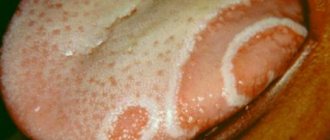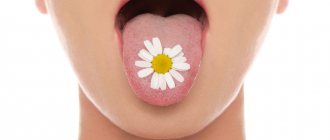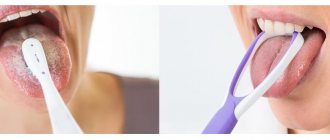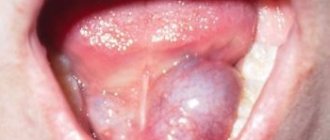What can cause a rough tongue and why is it dangerous?
Based on the condition of the tongue, the doctor often determines the condition of the digestive tract. If the tongue is rough, this may be a symptom of certain problems in the functioning of the internal organs. In normal condition, the mucous membrane of the muscular organ is pale pink, moist, and smooth. On its surface there are small filiform papillae, slightly velvety in appearance. In addition to filiform, there are 3 more types of papillae on the tongue (mushroom-shaped, grooved and leaf-shaped). These papillae are taste buds. If any changes occur in the appearance of the organ, this may be a signal of disturbances in the functioning of the internal organs.
Diagnosis and treatment
Any changes in the tongue indicate the development of the disease, a lack or excess of various compounds in the human body. In medicine there is the concept of linguodiagnostics. It refers to obtaining information about the state of the body by studying the linguistic surface.
If it becomes unpleasant to the touch, rough and other signs appear, you should visit a therapist, who, in turn, will refer the patient to a dentist, infectious disease specialist or gastroenterologist. The best period for diagnosis is morning. Diagnosis is carried out on an empty stomach. First, the doctor projects the location of the internal organs in the tongue, after which he notes the violations. The specialist also takes into account the color of the tongue, its shape, the presence of plaque and its shade, the mobility of this organ, as well as various formations, as a result of which it becomes clear why roughness and other symptoms began to be felt in the mouth.
Light plaque can be removed with and. To do this, it is recommended to purchase a special scraper or brush. For better cleansing, after these actions you should rinse your mouth with a disinfectant.
If regular cleaning cannot remove the plaque, and it is accompanied by roughness, you need to visit a doctor to diagnose the provoking disease.
In this case, the doctor will prescribe a comprehensive treatment for the underlying disease. With successful treatment, symptoms should disappear.
In addition, it is necessary to limit the consumption of fermented milk products and sweets, as well as give up bad habits (smoking, alcohol abuse).
Based on the condition of the tongue, the doctor often determines the condition of the digestive tract. If the tongue is rough, this may be a symptom of certain problems in the functioning of the internal organs. In normal condition, the mucous membrane of the muscular organ is pale pink, moist, and smooth. On its surface there are small filiform papillae, slightly velvety in appearance. In addition to filiform, there are 3 more types of papillae on the tongue (mushroom-shaped, grooved and leaf-shaped). These papillae are taste buds. If any changes occur in the appearance of the organ, this may be a signal of disturbances in the functioning of the internal organs.
Why does the symptom appear?
The overall picture of the oral cavity almost always directly affects the condition of the tongue. If there is caries, pulpitis, stomatitis, periodontitis or candidiasis in the mouth, all this affects its condition. Pathologies of a muscular organ can be independent or complement the clinical picture of other diseases in humans. Independent diseases are rare. These include various mechanical damage - injuries, burns, rubbing against braces, crowns or dentures.
If a rough tongue appears, this should be alarming. Often this can be a sign of an underlying disease. Often the appearance of roughness is accompanied by the appearance of plaque, inflammation of the papillae, a dry tongue appears, its surface is rough, geometric patterns appear on it, swelling, hyperemia of the mucous membrane, and an increase in the volume of the organ.
Sometimes dry mouth is a symptom accompanying the development of diabetes. In this case, the surface of the tongue is dry and slightly rough. Treatment should be aimed at eliminating the cause of this phenomenon. The most common causes of the appearance of rough mucous membrane of a muscular organ include:
- diseases of the endocrine system, in particular disorders of the thyroid gland;
- dysfunction in the functioning of the digestive system, liver and gallbladder;
- intestinal tract infections;
- chronic tonsillitis;
- glossitis (during its development, the tongue has a rough, painful mucous membrane);
- anemia;
- angina;
- alcohol or food intoxication, infectious diseases;
- long-term use of antibacterial drugs in large dosages;
- development of fungal microorganisms in the oral cavity.
Often the causes of dryness and roughness lie in severe dehydration of the body. General intoxication can occur due to poisoning and the development of intestinal infections. Liver dysfunction is also accompanied by similar symptoms. If the surface of the organ is covered with cracks, this may be a sign of diabetic disease or a malfunction of the endocrine system. The causes of dryness and roughness may lie in a significant deficiency or excess of vitamins or minerals in the body - hypovitaminosis or hypervitaminosis.
Paleness of the surface of the organ, which is accompanied by roughness, can signal malfunctions in the functioning of the digestive tract and stagnation of food. It is important to consult a doctor in a timely manner to determine the cause of such symptoms and begin adequate treatment in a timely manner. Diseases of the gallbladder and duodenum, for example, gastritis or gastroduodenitis, can also manifest themselves with such symptoms. Additionally, a bitter taste may be felt in the mouth.
Swelling and roughness of the mucous membrane can be a sign of diseases of the cardiovascular system, malfunctions of the urinary system, and spleen. The first symptom of a disorder in hematopoiesis is the appearance of ulcers of different sizes on the surface of the organ, dryness of the mucous membrane. And if additional pain appears in the epigastric region, a grayish coating, this indicates the development of gastritis, pancreatitis, gastroduodenitis, gastric or duodenal ulcers.
Irritation and roughness can occur after a thermal burn or mechanical injury (for example, constant rubbing against the sharp edges of a filling, prosthesis or crown). Therefore, you need to promptly contact your dentist and treat any problems that arise.
Therapeutic measures
Treatment of roughness involves eliminating the underlying cause that caused such symptoms. After the diagnosis, appropriate treatment is prescribed, which consists of an integrated approach. For local treatment of the oral cavity, rinses with antiseptic solutions are used. Anti-inflammatory lotions and applications are prescribed. Wound healing and painkillers are used if necessary.
The result of competent treatment and elimination of the main cause is complete cleansing of the surface of the organ, it becomes normal and healthy. For therapy at home, oral irrigation is used with antibacterial solutions and decoctions based on medicinal plants. Also cleansing with special devices, for example, a scraper, rinsing with rinses (Forest Balsam, Hepilor, Orasept, Listerine).
If any changes occur in the condition of a muscle organ, you should contact a therapist or dentist. Next, a diagnosis is prescribed - a general blood test is taken, a scraping from the tongue may be necessary (more often this procedure is carried out in the presence of plaque). If pathological processes are detected in the organs of the digestive system, appropriate therapy is applied with the help of medications (enzymes, anti-inflammatory, analgesic, non-steroidal anti-inflammatory drugs, sorbents, hepatoprotectors, endoprotectors).
You should not ignore such a symptom as roughness on the surface of the mucous membrane of the tongue. It is better to consult a doctor and not start self-treatment, as this can aggravate the course of the underlying disease and provoke its transition to the chronic stage, the treatment of which will be long and difficult.
Chief author and editor-in-chief: Makarskaya S.E., 29 years of experience.
Causes of rough surface and plaque
You should be wary in the following cases:
- plaque has appeared that cannot be removed after brushing your teeth;
- the tongue has become unusually rough;
- began to crack;
- increased;
- papillae become inflamed;
- geometric patterns appeared.
A symptom such as roughness is almost always accompanied by the appearance of a rash or plaque. These are symptoms of various diseases - from gastrointestinal lesions to diabetes.
Roughness is almost always accompanied by the appearance of a rash or plaque.
A small layer of white plaque in the morning upon waking is normal. It should completely disappear by lunchtime. This is simply an accumulation of particles of dead epithelial cells, food debris and mucin protein, which is found in saliva. Bacteria are also involved in its appearance. There are a lot of them in the oral cavity. At the same time, plaque is easily removed during brushing.
Oral hygiene can be an excellent preventive measure. It is useful to clean the surface of the tongue with a special scraper or brush. To consolidate the effect, you need to use mouthwash. This removes dangerous bacteria, food residues and other substances. The surface becomes clean, smooth and healthy.
If your tongue is rough with a white coating that cannot be removed by regular cleaning, or you feel discomfort, then you should consult a doctor. It will be necessary to undergo a comprehensive examination to identify the cause.
Let's consider the main reasons for the appearance of this pathology:
- Dehydration (the tongue becomes rough and dry), intoxication (in case of intestinal infections and poisoning), liver problems.
- Cracks can warn of disruptions in the endocrine system or diabetes.
- Lack or excess of nutrients.
- Stagnation of food. In this case, the unevenness is accompanied by cyanosis or pallor. This condition requires immediate medical attention.
- Disorders of the stomach, duodenum, and gallbladder. If gastritis develops, areas of peeling appear. There is also a bitter taste in the mouth.
- An uneven surface combined with swelling can warn of problems with the spleen, kidneys or heart.
- With blood diseases, ulcers appear.
- With an “acute abdomen,” the organ becomes enlarged, turns red, and becomes covered with a gray coating.
- With HIV, hairy leukoplakia can develop. With it, small villi appear on the tongue.
- When burned, the tongue also becomes rough.
Cracks can warn of disruptions in the endocrine system or diabetes.
Let's look at some pathological conditions in more detail.
What to do if a white coating appears on the tongue?
Before removing plaque effectively and efficiently, it is necessary to diagnose the causes of its appearance, since therapeutic tactics are based on eliminating their effects.
- For pathologies of the digestive system, conservative treatment is used, including antibiotics, antacids to reduce acidity, enzyme preparations, intestinal sorbents, hepatoprotectors and antispasmodics. The choice of these drugs is based on the nature of the diagnosed disease, its location and severity.
- In case of hypovitaminosis, multivitamins that contain B vitamins must be included in therapy.
- Treatment of bronchitis is based on the use of antibiotics (if it is infectious), bronchodilators and expectorants.
- Etiotropic therapy for scarlet fever and sore throat is carried out with the help of antibiotics and local antiseptics (lozenges for sore throat, gargling solutions).
- When diagnosing renal failure, therapy is carried out in a medical hospital, often using hemodialysis (hardware purification of the blood from metabolic products).
- Antifungal drugs in the form of a rinse solution or tablets will help get rid of plaque from a candidiasis infection.
The appearance of unexpressed white deposits in the morning can be the result of dry mouth and tongue, especially if the person breathed through the mouth at night. In this case, you can clean your tongue using a special hygienic brush. If white plaques on the tongue appear constantly and also persist throughout the day, then this sign indicates that this is a pathological reason for their development.
A healthy person's tongue should be smooth, moist and pink in color.
If there is a slight whitish coating, this is also considered normal.
It may appear velvety due to the presence of papillae that can be seen from a closer distance.
Sometimes the tongue begins to become rough and changes color.
What are the reasons for this phenomenon?
Any changes in a person’s language may indicate the development of a particular disease.
In medicine, there is even a special section that studies human diseases by examining his tongue.
The tongue can help identify a disease before its main symptoms appear.
Typically, the tongue becomes rough when salivation fails.
The tongue may become rough due to the fact that a person has taken certain medications and drugs, and the dose was too high.
A rough, dry tongue may indicate the presence of a disease such as diabetes.
If it is still covered with cracks, this may indicate that there are problems with the thyroid gland.
A rough tongue may indicate that the body is suffering from dehydration.
This phenomenon is often observed after a person has suffered from a high fever.
Dry mouth can also indicate such ailments as diarrhea, intestinal infection, peritonitis, appendicitis, peptic ulcer and others.
Similar symptoms can occur with simple dehydration, so don’t be alarmed in advance.
A rough tongue can cause burns, both thermal and chemical.
In order to relieve discomfort, you can lubricate your tongue with a special ointment.
If it is not possible to use ointment, you can moisten your tongue with boiled water. People suffering from ailments of the autonomic nervous system may complain of dry mouth during an exacerbation period.
The following symptoms will tell you about this disease: a rough tongue, dryness and discomfort in the mouth, it becomes difficult to swallow food.
A rough tongue can also be caused by frequent consumption of roasted seeds, use of toothpaste with ingredients that are not suitable for you, smoking, nuts, some mouth fresheners, caramel, and more.
Popular articles
- Every person in his daily activities has at least once encountered such unpleasant symptoms as pain of various types in the neck,…
A lumbar intervertebral hernia is a rupture of a spinal disc resulting from an uneven and strong load on the vertebrae. By…
In a healthy state, this organ has a pink tint. It must be clean and damp. If it becomes uneven and noticeable, then it’s time to take care of your health.
You should be wary in the following cases:
- plaque has appeared that cannot be removed after brushing your teeth;
- the tongue has become unusually rough;
- began to crack;
- increased;
- papillae become inflamed;
- geometric patterns appeared.
A symptom such as roughness is almost always accompanied by the appearance of a rash or plaque. These are symptoms of various diseases - from gastrointestinal lesions to diabetes.
Roughness is almost always accompanied by the appearance of a rash or plaque.
A small layer of white plaque in the morning upon waking is normal. It should completely disappear by lunchtime. This is simply an accumulation of particles of dead epithelial cells, food debris and mucin protein, which is found in saliva. Bacteria are also involved in its appearance. There are a lot of them in the oral cavity. At the same time, plaque is easily removed during brushing.
Oral hygiene can be an excellent preventive measure. It is useful to clean the surface of the tongue with a special scraper or brush. To consolidate the effect, you need to use mouthwash. This removes dangerous bacteria, food residues and other substances. The surface becomes clean, smooth and healthy.
If your tongue is rough with a white coating that cannot be removed by regular cleaning, or you feel discomfort, then you should consult a doctor. It will be necessary to undergo a comprehensive examination to identify the cause.
Let's consider the main reasons for the appearance of this pathology:
- Dehydration (the tongue becomes rough and dry), intoxication (in case of intestinal infections and poisoning), liver problems.
- Lack or excess of nutrients.
- Stagnation of food. In this case, the unevenness is accompanied by cyanosis or pallor. This condition requires immediate medical attention.
- Disorders of the stomach, duodenum, and gallbladder. If gastritis develops, areas of peeling appear. Also joins.
- An uneven surface combined with swelling can warn of problems with the spleen, kidneys or heart.
- With blood diseases, ulcers appear.
- With an “acute abdomen,” the organ becomes enlarged, turns red, and becomes covered with a gray coating.
- With HIV, hairy skin can develop. With it, small villi appear on the tongue.
- When burned, the tongue also becomes rough.
Cracks can warn of disruptions in the endocrine system or diabetes.
Let's look at some pathological conditions in more detail.
Gastrointestinal diseases
Gastroenterologists know that white plaque can be a symptom of problems with the gastrointestinal tract. The surface of the mucous membrane is smooth and dry. This often happens with the development of gastritis with low acidity. This is a clear sign that inflammation has begun in the gastric mucosa. But a rough surface may indicate that the acidity of gastric juice has increased significantly.
Gastritis is easy to diagnose by symptoms such as heartburn, burning and pain in the esophagus and stomach. If the disease is chronic, the symptoms will not be as severe as in the acute form. Such patients often break into a sweat and feel general weakness.
The ulcer may cause plaque and red spots in the middle of the tongue. A duodenal ulcer causes a burning sensation, a feeling of heartburn.
White plaque may be a symptom of gastrointestinal problems.
Colitis and enterocolitis provoke the appearance of plaque at the base of the tongue. It swells quite a lot. Because of this, teeth marks can be seen along its edges. In such patients, bowel movements are disrupted, they complain of nausea and pain.
Other reasons
If a white coating appears on the tip of the tongue, this indicates inflammation of the bronchial tubes. But the location at the base and on the sides can warn of renal failure. This is a very serious diagnosis that needs to be given the highest attention.
Other symptoms of this most dangerous disease are an unpleasant odor and dry mouth, constant fatigue, and weakness. Such patients cannot withstand even slight physical exertion. If these symptoms occur, you should consult a nephrologist.
A rough tongue can also occur in diabetes. It is knitted, and a dense gray coating is visible on it. It is located in the center. These symptoms are explained by the fact that diabetes may impair the function of the glands located under the jaw. They produce less saliva and the following symptoms appear.
If a white coating appears on the tip of the tongue, this indicates inflammation of the bronchial tubes.
With glossitis, the white plaque is accompanied by a burning sensation, pain and loss of taste.
With anemia, red spots form on the tongue, around which a white coating is visible. This is due to the process of atrophy.
Note! A dense white coating can warn that a malignant neoplasm has appeared in the gastrointestinal tract.
As you can see, the reasons can be very serious. If the plaque is not removed after cleaning and other symptoms are added to it, the tongue has become rough, it is better to consult a doctor about this problem.
Why does a white coating form?
The following criteria will help determine the reason why the tongue is covered with a white coating:
- separation of the formed film. The denser it is, the more difficult it is to clean off. Its appearance indicates the progression of the disease;
- layer thickness. A thin film indicates the onset of pathology. The deep layer signals the presence of chronic infectious processes;
- consistency. A whitish curdled mass may indicate the development of a fungal disease. Its dryness signals dehydration. A dense and thick layer indicates the presence of infection.
The reasons for the appearance of a whitish layer can be dental and non-dental.
The cause of the plaque can be determined by its location:
| Location | Possible reasons |
| Center | Impaired functioning of the stomach, developing gastritis. |
| Base | A white coating at the very base of the tongue signals that the intestines are clogged. If there are cracks in the organ, this indicates the onset of an ulcer of the duodenum or stomach. |
| Sides | A whitish layer formed on the sides of the tongue is often observed in smokers. What does it mean? The symptom signals the development of pulmonary pathologies. |
| Interior | Plaque under the tongue indicates the progression of candidiasis. |
| End | A whitish coating on the tip indicates diseases of the rectum. |
| Sky | White plaque on the palate often indicates the development of candidal stomatitis. More common in children than in adults. |
White spots on the tongue, located in different places, indicate the presence of a fungal infection.
The color of plaque on the tongue is:
- grayish (gastritis);
- blue (dysentery, typhoid fever);
- yellow-white (enterocolitis).
If white spots located over the entire surface alternate with red spots, this may indicate the development of scarlet fever.
Infections
Another reason is infections. The microflora in the mouth is quite rich. Along with beneficial bacteria, it also contains pathogenic microflora. It is this that can cause unevenness on the surface of the tongue and a white coating. Very often, such manifestations are observed when infected with Candida fungus. It is present in the body of each of us.
The surface of the tongue may change with sore throat.
With normal immunity, this fungus is contained and does not multiply. But a weakened immune system does not cope well with it. This disease is popularly called thrush, and in medicine it is candidiasis. In this case, the oral mucosa and tongue are affected. A characteristic feature is a cheesy coating.
Sore throat also provokes plaque. This is due to the fact that staphylococci and streptococci enter the mucous membrane. Patients suffer from fever, pain and burning in the throat. If it is tonsillitis, then a yellow coating forms at the base of the tongue and on the tonsils.
Another pathology is leukoplakia. It can be confused with thrush. A distinctive symptom is keratinization of the mucous membrane, burning, red and white spots. They are located on the sides and top of the tongue. If you have such symptoms, you should consult a doctor. Leukoplakia can cause malignant tumors.
Infections in the mouth
In addition to stomach diseases, disruptions of the endocrine system and abdominal organs, infections can cause a rough surface and white plaque. The microflora of the oral cavity contains enough pathogenic microbes, including fungal ones, for example, candida. They are kept in balance with beneficial bacteria by the immune system, and if the defense weakens, the balance is disrupted and the body is subject to constant attacks of infections.
Plaque can be caused by a disease such as tonsillitis (tonsillitis) of catarrhal, lacunar and follicular types. The culprits of the pathology are mainly streptococci and staphylococci and are characterized by low-grade fever, pain and burning in the throat. With fibrinous tonsillitis, a layer of yellow plaque appears on the tonsils, which often covers the base of the tongue.
It is impossible not to note such a disease as candidiasis, caused by the Candida fungus. In everyday life it is called thrush, due to a thick layer of white coating on the tongue, somewhat reminiscent of cottage cheese. If you carefully peel it off, you will see an irritated, red surface underneath that sometimes bleeds. In addition, candidiasis in chronic form often appears against the background of HIV infection.
Candidiasis is often confused with leukoplakia, which is characterized by increased keratinization of the surface layer of the mucosa. With this disease, a burning sensation and plaque appears in the form of white and red spots on the upper and lateral parts of the tongue. In addition, there are also flat and verrucous forms of leukoplakia. The first is characterized by flat spots, and the second is slightly raised, but regardless of the type of disease, you should contact a medical facility if such symptoms are detected, because it can eventually develop into a malignant formation.
The most common disease characterized by such symptoms is stomatitis. Initially, the gums and tongue become swollen and red, and then a white coating appears on the tongue. It is recommended to begin treatment immediately after the first signs appear, before small painful ulcers begin to spread throughout the mucous membrane.
There are a whole lot of reasons why the tongue becomes knotted, becomes rough and a white coating appears on it, and only a doctor can correctly diagnose the disease, so you should not delay your visit to him and as soon as the opportunity arises, go to the hospital.
Treatment
If the tongue is uneven, you need to fight the underlying disease. The doctor makes a diagnosis and prescribes comprehensive treatment. To alleviate the condition, rinsing with antiseptic solutions may be prescribed locally. Creams and ointments are also prescribed. They relieve pain, inflammation, and accelerate healing. At home, treatment boils down to cleaning, rinsing, and applying ointments.
A rough tongue and plaque on it are symptoms of a number of diseases. Only a doctor can accurately determine the cause in a particular case. Even he will need to diagnose and prescribe a series of tests for the patient. But self-medication can lead the disease to an advanced form. Then it will be much more difficult to overcome it.
Tongue is an indicator of health
It is recommended to examine the tongue in the morning, on an empty stomach. In a healthy person, its color is pale pink, and the taste buds are easily distinguishable. Normally, it has a faint whitish coating that can be easily removed with a toothbrush or a special scraper. The complete absence of such cover should be no less alarming than its excessive amount.
Any changes that occur in the oral cavity should attract a person’s attention. They may indicate the formation of pathological processes in the body. A decrease in the amount or complete cessation of saliva production leads to the development of severe dry mouth. A rough tongue will immediately signal this to a person, since due to a lack of moisture on its surface, difficulties will arise when swallowing and chewing food.
Dry tongue can occur with severe nervous excitement or stress. From a physiological point of view, this is a normal situation. As soon as the person calms down, saliva production returns to normal. If there have been no emotional upheavals, and dryness has been observed for a long time, you should look for other causes of a rough tongue. An experienced doctor will help in this situation.
The causes of dry tongue may be the following:
- dehydration and intoxication;
- heart pathologies;
- tongue burn;
- disorders of the gastrointestinal tract;
- glossitis;
- chronic tonsillitis;
- liver pathologies;
- stagnation of food;
- blood diseases;
- HIV;
- kidney problems;
- long-term use of antibiotics;
- inflammation of the salivary glands, as well as their malignant and benign tumors;
- diabetes;
- infectious lesions.
Despite the impressive list of pathologies that cause roughness and dryness of the tongue, diseases of the gastrointestinal tract, pulmonary system, and infections are most often diagnosed. Only a doctor can make a correct diagnosis after a thorough diagnosis. He will prescribe treatment that will help defeat the underlying disease. After this, the rough tongue will definitely return to normal.
Rough tongue: causes, possible diseases, treatment methods and reviews
At home, you can conduct a quick health diagnosis yourself. All that is necessary for this is to examine the tongue with a mirror. A change in its color and shape will tell you a lot about the functioning of internal organs. This simple method should not be neglected. With its help, you can prevent the development of dangerous pathologies in time. Some of them are indicated by a rough tongue.
Tongue is an indicator of health
It is recommended to examine the tongue in the morning, on an empty stomach. In a healthy person, its color is pale pink, and the taste buds are easily distinguishable. Normally, it has a faint whitish coating that can be easily removed with a toothbrush or a special scraper. The complete absence of such cover should be no less alarming than its excessive amount.
Any changes that occur in the oral cavity should attract a person’s attention. They may indicate the formation of pathological processes in the body.
A decrease in the amount or complete cessation of saliva production leads to the development of severe dry mouth.
A rough tongue will immediately signal this to a person, since due to a lack of moisture on its surface, difficulties will arise when swallowing and chewing food.
Dry tongue can occur with severe nervous excitement or stress. From a physiological point of view, this is a normal situation. As soon as the person calms down, saliva production returns to normal. If there have been no emotional upheavals, and dryness has been observed for a long time, you should look for other causes of a rough tongue. An experienced doctor will help in this situation.
The causes of dry tongue may be the following:
- dehydration and intoxication;
- heart pathologies;
- tongue burn;
- disorders of the gastrointestinal tract;
- glossitis;
- chronic tonsillitis;
- liver pathologies;
- stagnation of food;
- blood diseases;
- HIV;
- kidney problems;
- long-term use of antibiotics;
- inflammation of the salivary glands, as well as their malignant and benign tumors;
- diabetes;
- infectious lesions.
Despite the impressive list of pathologies that cause roughness and dryness of the tongue, diseases of the gastrointestinal tract, pulmonary system, and infections are most often diagnosed.
Only a doctor can make a correct diagnosis after a thorough diagnosis. He will prescribe treatment that will help defeat the underlying disease.
After this, the rough tongue will definitely return to normal.
Reflexes that can influence the motor and secretory functions of the stomach and intestines are produced by tongue receptors. The opposite effect also occurs.
That is, internal organs influence the appearance of pathological reflexes on the surface of the tongue. For example, its rough root and white coating will tell the doctor that the patient suffers from gastritis with low acidity.
Pain and burning sensations in the esophagus, heartburn can complement the clinical picture.
A rough tongue covered with a gray coating may indicate the development of an intestinal ulcer. An additional factor indicating this pathology is heartburn and a burning sensation in the mouth.
Colitis, in addition to roughness, is characterized by an increase in the size of the tongue; teeth marks may even remain along its edges. With duodenitis and biliary dyskinesia, the thickness of the plaque increases significantly. A slight roughness of the tongue rarely causes discomfort. But a dense coating can negatively affect the sense of taste, reducing the sensitivity of the papillae.
Diseases of the pulmonary system
A white, rough tongue occurs in patients at an early stage of the development of diseases of this organ. Inflammation in the bronchi is indicated by a thick and dry plaque located at its tip.
If it begins to thicken and acquire a yellow tint, this will tell the doctor that the pathology is progressing. Additionally, the patient will experience other symptoms.
For example, weakness, unpleasant odor and dry mouth.
Characteristic changes in the condition of the tongue are observed in pathologies such as scarlet fever. First, an extensive yellow or gray-white coating forms. It thickens every day. The fungiform papillae are clearly visible under the plaque. They are distinguished by a rich red color and are surrounded by a white border. After a week, the plaque disappears, and the tongue changes color to crimson.
Infectious and other diseases
There are many pathogenic fungi and bacteria in the oral cavity. Their growth is inhibited by the body's immune system. As soon as its operation fails, the infection begins its attack.
In humans, a rough tongue and a white coating on the tonsils may indicate the development of follicular or catarrhal tonsillitis. The disease is accompanied by a sore throat and fever. The causative agents of the disease are streptococci and staphylococci.
The culprit of oral thrush is the fungus Candida. A very dense white coating appears on the surface of the tongue. If you try to remove it, the mucous membrane underneath will begin to bleed. The development of this chronic pathology is observed in patients with HIV infection.
Dry tongue is accompanied by disruption of the thyroid gland. Symptoms such as sweating, loss of appetite, diarrhea, irritability and anxiety are observed.
Diabetes mellitus is characterized by the development of thirst, the patient’s tongue becomes rough and dry.
If dense white plaque is concentrated on its sides and tip, this may indicate the development of hidden renal failure. This is a very serious problem that can cause death. Therefore, if you notice such formations on your tongue, you should immediately consult a doctor.
Leukoplakia
Leukoplakia affects the mucous membranes. Often this is the reason why the tongue becomes rough. This pathology can be easily confused with thrush. A white coating also appears on the tongue, but it has clearly defined edges. Its surface is rough and dry. It is impossible to remove plaque with a spatula.
The reasons for the development of this pathology have not been fully identified. It is believed that the main role is played by provoking factors: thermal, physical and chemical irritation. Particularly dangerous is the influence of several agents at once.
For example, irritation by galvanic current, which is formed as a result of the use of dissimilar metal prostheses. As well as mechanical damage to the mucous membrane from dental instruments.
In smokers, leukoplakia can occur as a result of exposure to smoke and high temperatures.
Internal factors play an important role in the development of the disease. These are hormonal abnormalities, gastroenterological diseases, and lack of vitamin A. The danger of the disease is that it can gradually transform into cancer.
Diagnosis and treatment
The doctor can prescribe treatment only after he determines exactly why the tongue is rough. Sometimes the cause can be identified immediately and there is no need for numerous diagnostic procedures. But in some cases it may be necessary:
- complete blood count;
- bacteriological study of oral microflora;
- gastroscopy;
- Ultrasound;
- bronchoscopy;
- acid reflux test.
Once the underlying disease is identified, the doctor will be able to prescribe treatment for the patient. The tongue will return to normal as soon as the patient’s condition begins to improve. To eliminate dry mouth and reduce pain, the doctor additionally prescribes rinses with various antiseptics.
Treatment with traditional methods
There are several effective traditional medicine recipes that help alleviate the patient’s condition. It is recommended to rinse a rough tongue with infusions of the following medicinal plants:
- sage;
- chamomile;
- calendula;
- Oak bark;
- mint;
- sea buckthorn.
To prepare the infusion, pour a teaspoon of the selected ingredient into a glass of boiling water and leave for several minutes. After the liquid has cooled, it is filtered and used for rinsing. You can add a drop of iodine, aloe juice or honey to the finished infusion.
In addition, you can put a cotton pad soaked in rosehip oil, propolis tincture or a mixture of carrot and potato juices on your tongue for a few minutes. This procedure will relieve pain, moisturize, soothe and disinfect the mucous membrane. After 3-5 minutes, the cotton pad should be removed and your mouth should be rinsed with warm water.
Reviews about the treatment
Patients often leave reviews about how they managed to cure a rough tongue. In some cases, therapy does not take much time. Improvement occurs quickly after using regular rinses with medicinal herbs. Lubricating the surface of the tongue with sea buckthorn oil gives good results.
In the event that dryness, plaque and roughness of the tongue are associated with the development of serious pathologies, it is not possible to manage only with antiseptic rinses. Patients often write that they have come a long way before they were given the correct diagnosis. Only after complete recovery were they able to forget about the problem of dry and rough tongue.
Source: https://FB.ru/article/433960/shershavyiy-yazyik-prichinyi-vozmojnyie-zabolevaniya-metodyi-lecheniya-i-otzyivyi
Why does the symptom appear?
The overall picture of the oral cavity almost always directly affects the condition of the tongue. If there is caries, pulpitis, stomatitis, periodontitis or candidiasis in the mouth, all this affects its condition. Pathologies of a muscular organ can be independent or complement the clinical picture of other diseases in humans. Independent diseases are rare. These include various mechanical damage - injuries, burns, rubbing against braces, crowns or dentures.
If a rough tongue appears, this should be alarming. Often this can be a sign of an underlying disease. Often the appearance of roughness is accompanied by the appearance of plaque, inflammation of the papillae, a dry tongue appears, its surface is rough, geometric patterns appear on it, swelling, hyperemia of the mucous membrane, and an increase in the volume of the organ.
Sometimes dry mouth is a symptom accompanying the development of diabetes. In this case, the surface of the tongue is dry and slightly rough. Treatment should be aimed at eliminating the cause of this phenomenon. The most common causes of the appearance of rough mucous membrane of a muscular organ include:
- diseases of the endocrine system, in particular disorders of the thyroid gland;
- dysfunction in the functioning of the digestive system, liver and gallbladder;
- intestinal tract infections;
- chronic tonsillitis;
- glossitis (during its development, the tongue has a rough, painful mucous membrane);
- anemia;
- angina;
- alcohol or food intoxication, infectious diseases;
- long-term use of antibacterial drugs in large dosages;
- development of fungal microorganisms in the oral cavity.
Often the causes of dryness and roughness lie in severe dehydration of the body. General intoxication can occur due to poisoning and the development of intestinal infections. Liver dysfunction is also accompanied by similar symptoms. If the surface of the organ is covered with cracks, this may be a sign of diabetic disease or a malfunction of the endocrine system. The causes of dryness and roughness may lie in a significant deficiency or excess of vitamins or minerals in the body - hypovitaminosis or hypervitaminosis.
Paleness of the surface of the organ, which is accompanied by roughness, can signal malfunctions in the functioning of the digestive tract and stagnation of food. It is important to consult a doctor in a timely manner to determine the cause of such symptoms and begin adequate treatment in a timely manner. Diseases of the gallbladder and duodenum, for example, gastritis or gastroduodenitis, can also manifest themselves with such symptoms. Additionally, a bitter taste may be felt in the mouth.
Swelling and roughness of the mucous membrane can be a sign of diseases of the cardiovascular system, malfunctions of the urinary system, and spleen. The first symptom of a disorder in hematopoiesis is the appearance of ulcers of different sizes on the surface of the organ, dryness of the mucous membrane. And if additional pain appears in the epigastric region, a grayish coating, this indicates the development of gastritis, pancreatitis, gastroduodenitis, gastric or duodenal ulcers.
Irritation and roughness can occur after a thermal burn or mechanical injury (for example, constant rubbing against the sharp edges of a filling, prosthesis or crown). Therefore, you need to promptly contact your dentist and treat any problems that arise.
Pathologies of the digestive tract
Reflexes that can influence the motor and secretory functions of the stomach and intestines are produced by tongue receptors. The opposite effect also occurs. That is, internal organs influence the appearance of pathological reflexes on the surface of the tongue. For example, its rough root and white coating will tell the doctor that the patient suffers from gastritis with low acidity. Pain and burning sensations in the esophagus, heartburn can complement the clinical picture.
A rough tongue covered with a gray coating may indicate the development of an intestinal ulcer. An additional factor indicating this pathology is heartburn and a burning sensation in the mouth.
Colitis, in addition to roughness, is characterized by an increase in the size of the tongue; teeth marks may even remain along its edges. With duodenitis and biliary dyskinesia, the thickness of the plaque increases significantly. A slight roughness of the tongue rarely causes discomfort. But a dense coating can negatively affect the sense of taste, reducing the sensitivity of the papillae.
Symptoms of xerostomia
Dry tongue and lips are not isolated symptoms; they are also accompanied by other signs of disturbances in the functioning of the body.
Symptoms of chronic dryness include:
- Constant feeling of thirst.
- Sore throat, burning sensation in the nose.
- Dry lips, cracks in the corners of the mouth.
- Frequent urination.
- Slurred speech.
- Burning in the mouth.
- Redness and white coating on the tongue, cheeks.
- Bad breath.
- Changes in taste perception of food and drinks.
- Hoarse voice.
Rough tongue
The oral cavity is an indicator of the state of the body. Its overall picture always affects the well-being of the language. Untreated teeth (caries, pulpitis), periodontitis, stomatitis, candidiasis - these manifestations of ill health in the mouth are immediately reflected in it. Pathologies of the main muscle can be either independent or a consequence of various problems in the body. Independent organ damage is less common. These are various injuries, burns, calluses from constant friction against a brace or a sharp edge of a tooth.
You need to be wary if the following language changes appear:
- excessive roughness;
- white, yellow or other colored coating;
- inflammation of the papillae;
- dry, cracked tongue;
- geometric patterns on the surface;
- swelling and increase in volume.
Sometimes dry mouth can be a sign of diabetes, in which case Diabenote capsules for diabetes will be a good help.
Causes and treatment of rough tongue
The most common reasons:
- Thyroid diseases.
- Problems in the functioning of the stomach and gallbladder.
- Intestinal infections.
- Chronic tonsillitis.
- Glossitis is various inflammatory processes of the tongue.
- Long-term use of antibiotics in large quantities.
- Infectious lesions caused by fungal microorganisms.
More details about the reasons:
1) Often the cause of dryness and roughness is severe dehydration. General intoxication of the body due to poisoning and intestinal infections. And also “problems” in the liver.
2) If cracks appear on the surface of the organ, then perhaps this is a sign of diabetic disease or dysfunction in the human endocrine system.
3) The causes of a rough tongue are a significant deficiency or excess of any useful substances. This is a reaction to hypervitaminosis or hypovitaminosis.
4) The spines give the organ its roughness. If they change color from pink to bluish. And the tongue has become pale, this indicates stagnation of food in the middle sections of the digestive tract. This violation requires prompt medical intervention.
Green coating on the tongue: causes and treatment
How to clear plaque from your tongue: causes of plaque on the tongue and how to remove it
What causes a white tongue in an adult or child: causes, treatment (what to do if there is a white coating in the mouth)
5) Problems with the functioning of the stomach, gall bladder, and duodenum explain why the tongue is rough. With gastritis, gastroduodenitis, the formation of flaky areas is possible. There is also a bitter taste in the mouth.
6) A swollen and rough tongue can be one of the signs of heart, kidney or spleen disease.
7) The first symptom of blood diseases are ulcers on the tongue that vary in size and severity.
 But with abdominal pain, diagnosed as “acute abdomen,” the tongue becomes reddish and increases in size. Has a grayish coating.
But with abdominal pain, diagnosed as “acute abdomen,” the tongue becomes reddish and increases in size. Has a grayish coating.
9) A person with HIV infection may have hairy leukoplakia - a serious disease due to weakened immunity. When light or dark colored hair appears over the entire area of the organ.
10) An irritated and rough coating may be associated with a chemical or thermal burn.
Another natural remedy for weight loss is lipo star system https://fupiday.com/lipo-star-system.html, they write that they lose weight quickly with LSS.
Temporary feeling of thirst
Drying of the mucous membrane has many causes, including those not related to pathological processes.
Excessive proliferation of adenoid lymphoid tissue, which often occurs in childhood, or a deviated nasal septum, a problem in adults, can lead to predominance of mouth breathing, especially at night. In this case, a person feels dry, a sensation of “swollen” tongue in the morning. During the day the condition was not disturbed in any way.
The mucous membrane may dry out in response to the use of certain medications: sedatives, antidepressants, antiallergic drugs, analgesics. The drying effect occurs with prolonged use or abuse of medications.
Many medications cause dry mouth
Most antibiotics, antifungals, and blood pressure medications cause increased thirst.
Moderate but constant dryness of the oral mucosa can be observed during hormonal changes in women during pregnancy and menopause. This is due to the fact that secretory functions (including saliva production) are regulated by hormones. In old age, dryness is a common manifestation.
Drinking enough fluids is essential in old age
Smoking is a bad habit that leads to a gradual decrease in the functioning of the salivary glands, the formation of a chronic inflammatory process in the bronchi, which in combination leads to dryness of the oral mucosa, and the tongue becomes covered with a yellow coating.
A smoker's tongue is dry and unpleasantly coated.
Infectious diseases
Viral infection, high fever, and intoxication of the body are manifested by a feeling of thirst and increased dryness in the mouth.
- Diseases such as a runny nose, all types of sinusitis, adenoiditis, provoke the development of mouth breathing, which invariably leads to increased dryness of the mucous membrane, a burning sensation in the mouth, and a desire to drink.
- Rotovirus infection, which affects the intestines, causes dehydration of the body, where dry muscle organ is one of the manifestations of the disease. In addition, dyspeptic disorders, fever, weakness, and severe fatigue occur.
- Bacterial infection of the throat and oral cavity: pharyngitis, tonsillitis, glossitis, stomatitis, also accompanied by a feeling of dry mucous membranes. But to this symptom there are also specific signs characteristic of each disease separately: high fever, pain when swallowing and speaking, swelling of the mucous membranes, cough, dirty white coating on the tongue and tonsils.
Sore throat is the cause of thirst
- Fungal inflammation occurs with vague symptoms, without obvious signs of illness. The main indicator of a fungal infection is a dense white coating on the tongue, dryness, itching, the appearance of small cracks, and hyperemia of adjacent tissues.
Dryness as a sign of disease of the abdominal organs
The condition of the tongue is invariably associated with the health of the digestive tract. In case of any deviations in the operation of the system, the language is the first to react to changes. What can the appearance of the taste organ in combination with other signs indicate?
Dryness at night is caused by snoring
Acute gastritis is manifested by severe pain in the epigastrium, so symptoms such as dry mouth, nausea, and increased sweating are secondary. With chronic gastritis, the signs of which are not so obvious, the appearance of the tongue matters. A persistent gray-white coating is noted along the midline, with the tip of the tongue and lateral surfaces remaining clean.
The dryness is not severe, but constant, and heartburn occurs periodically. There is a feeling of discomfort and heaviness in the epigastrium.
Dry and chapped lips due to stomach problems
The combination of dryness with burning and the appearance of bitterness, which changes the taste of food, indicates problems with the liver or gall bladder. The appearance of congestion in the biliary tract is determined by the appearance of a yellowish or greenish coating on the tongue.
Chronic pancreatitis, unlike acute pancreatitis, occurs in a latent form. Its first signs are: dryness of the oral mucosa, the appearance of cracks, and systematically occurring bloating. Similar sensations arise from the abuse of fatty, fried, spicy foods, and alcohol.
Intestinal diseases are similar in symptoms to the manifestations of chronic pancreatitis, but differ in the appearance of a yellow coating closer to the root of the tongue. In all cases of poisoning, the taste organ is the first to react by changing the condition of the mucous membrane, dryness, burning, and scattered white plaque appear.
The feeling of thirst is intensified by the appearance of dyspeptic disorders (vomiting, diarrhea), causing dehydration of the body. Spasmodic pain appears in the abdomen.
Treatment
Treatment for a rough tongue consists of eliminating the cause that caused this condition. The doctor, having diagnosed the disease, treats it. Complex therapy is carried out. Rinse with antiseptic solutions is applied locally. Anti-inflammatory, wound-healing and analgesic ointments and creams are applied. As a result of proper treatment and healing from the underlying ailment, the surface of the tongue is cleansed and it takes on a normal, healthy appearance.
Treatment at home consists mainly of irrigating the mouth and brushing the tongue with a toothbrush. These measures can remove surface plaque and reduce inflammation of the mucous membrane in the mouth. For a complete recovery, it is necessary to treat the underlying disease that caused this or that pathology of the tongue with medications.
If you are sure that parasites are to blame for the problem, try Helmifort, they say Helmifort works wonders.
Attentive attention to your well-being and, in particular, to the condition of the oral cavity will maintain good health until old age. Will prevent many serious diseases. If unusual neoplasms appear on the surface of the tongue, you should consult a specialist and not self-medicate. This will only make the situation worse. And it can lead to complications of the underlying disease.









